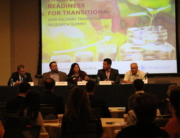by Lily Cao
Some leaders from the Los Angeles Veterans Collaborative recently attended a week-long summit on collective impact where they discovered new and innovative strategies that can be applied to ongoing work in the local veteran community.
Held in Vancouver, Canada, the Tamarack Institute’s Collective Impact Summit introduced keynote speakers, insightful workshops and organized learning groups that each tackled one of the five key conditions of collective impact: common agendas, shared measurement, mutually reinforcing activities, continuous communication and backbone support.
Attendees heard testimonies from forward-thinking professionals who have adopted this approach to tackle such pressing issues as poverty, racism and homelessness. They also shared their personal successes and challenges with implementing a collaborative working model rooted in community engagement.
Convened by the USC Center for Innovation and Research on Veterans & Military Families (CIR), the Los Angeles Veterans Collaborative is a network of more than 400 organizations and stakeholders that meets monthly to discuss some of the most pressing issues facing the local military population. It develops strategies and programs to bridge gaps in services across a number of areas, like health, behavioral health, homelessness, career advancement, families, higher education, legal and faith-based measures.
Nathan Graeser, CIR’s community program administrator, said one of the powerful ideas presented at the summit was the necessity to quickly adapt to failing programs.
“Within the veteran space, there’s an unnecessary prolongation of ineffective programs and interventions that fail to address the needs of our service members,” Graeser said. “The problems that transitioning veterans face are complex and require us to be able adapt community strategies to allow us to gather data and quickly apply our learning to inform interventions.”
“To allow things to ‘fail fast’ is a bold and enterprising idea that doesn’t waste time and allows you to make progress and move forward.”
CIR recently launched a community initiative funding program that will allow collaborative members to pilot their innovative ideas to serve veterans and their families. Their findings—whether successful or failures—would then inform the collaborative’s larger strategy across the veteran service provider spectrum.
For Lisa Anderson, co-chair of the collaborative’s career advancement working group, the biggest takeaway was the significance of identifying commonalities within personal goals in order to achieve large-scale social change.
“There is a necessity for our working groups to regroup and reassess our goals in order to make informed decisions as a whole,” said Anderson, a program manager at Salvation Army – Haven. “By starting out with a common agenda, and using it to drive our development for efficient strategies, then we can influence and effect systemic change.”
Steve Renahan, co-chair of the housing and homelessness working group, agreed that it is important to assess overlap among the collaborative’s organizations.
“If done right, this approach has the capacity to empower and inform the wide range of organizations within the LAVC—each with different missions and capacities—to collaborate for veterans. This is a powerful and insightful idea that is transferrable all across the Los Angeles County.”








